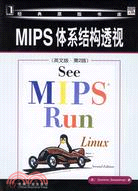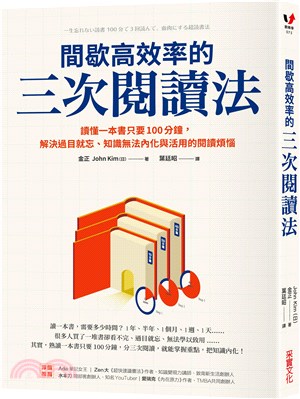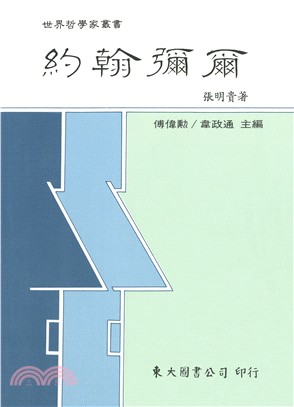MIPS體系結構透視(英文版·第2版)(簡體書)
- ISBN13:9787111206811
- 出版社:機械工業出版社
- 作者:(英)斯威特曼(Sweetman; D.)
- 裝訂/頁數:平裝/492頁
- 版次:1
- 出版日:2007/02/01
商品簡介
作者簡介
目次
1.1 Pipelines
1.2 The MIPS Five-Stage Pipeline
1.3 RISC and CISC
1.4 Great MIPS Chips of the Past and Present
1.5 MIPS Compared with CISC Architectures
Chapter 2: MIPS Architecture
2.1 A Flavor of MIPS Assembly Language
2.2 Registers
2.3 Integer Multiply Unit and Registers
2.4 Loading and Storing: Addressing Modes
2.5 Data Types in Memory and Registers
2.6 Synthesized Instructions in Assembly Language
2.7 MIPS I to MIPS64 ISAs: 64-Bit (and Other) Extensions
2.8 Basic Address Space
2.9 Pipeline Visibility
Chapter 3: Coprocessor 0: MIPS Processor Control
3.1 CPU Control Instructions
3.2 What Registers Are Relevant When?
3.3 CPU Control Registers and their encoding
3.4 CP0 Hazards?A Trap for the Unwary
Chapter 4: How Caches work on MIPS
4.1 Caches and Cache Management
4.2 How Caches Work
4.3 Write-Through Caches in Early MIPS CPUs
4.4 Write-Back Caches in MIPS CPUs
4.5 Other Choices in Cache Design
4.6 Managing Caches
4.7 L2 and L3 caches
4.8 Cache Configurations for MIPS CPUs
4.9 Programming MIPS32/64 Caches
4.10 Cache Efficiency
4.11 Reorganizing Software to Influence Cache Efficiency
4.12 Cache Aliases
Chapter 5: Exceptions, Interrupts, and Initialization
5.1 Precise Exceptions
5.2 When Exceptions Happen
5.3 Exception Vectors: Where Exception Handling Starts
5.4 Exception Handling: Basics
5.5 Returning from an Exception
5.6 Nesting Exceptions
5.7 An Exception Routine
5.8 Interrupts
5.9 Starting Up
5.10 Emulating Instructions
Chapter 6: Low-level Memory Management and the TLB
6.1 The TLB/MMU hardware and what it does
6.2 TLB/MMU Registers Described
6.3 TLB/MMU Control Instructions
6.4 Programming the TLB
6.5 Hardware-friendly page tables and refill mechanism
6.6 Everyday Use of the MIPS TLB
6.7 Memory Management in a simpler OS
Chapter 7: Floating-Point Support
7.1 A Basic Description of Floating Point
7.2 The IEEE754 Standard and Its Background
7.3 How IEEE Floating-Point Numbers Are Stored
7.4 MIPS Implementation of IEEE754
7.5 Floating-Point Registers
7.6 Floating-Point Exceptions/Interrupts
7.7 Floating-Point Control: The Control/Status Register
7.8 Floating-Point Implementation Register
7.9 Guide to FP Instructions
7.10 Paired-single floating-point instructions and MIPS 3D.
7.11 Instruction Timing Requirements
7.12 Instruction Timing for Speed
7.13 Initialization and Enabling on Demand
7.14 Floating-Point Emulation
Chapter 8: Complete Guide to the MIPS Instruction Set
8.1 A Simple Example
8.2 Assembler Instructions and What They Mean
8.3 Floating-Point Instructions
8.4 Differences in MIPS32/64 Release
8.5 Peculiar Instructions and Their Purposes
8.6 Instruction Encodings
8.7 Instructions by Functional Group
Chapter 9: Reading MIPS Assembler Language
9.1 A Simple Example
9.2 Syntax Overview
9.3 General Rules for Instructions
9.4 Addressing Modes
9.5 Object file and memory layout
Chapter 10: Porting Software to MIPS
10.1 Low-level software for MIPS: A Checklist of Frequently Encountered Problems
10.2 Endianness: Words, Bytes, and Bit Order
10.3 Trouble With Visible Caches
10.4 Memory access ordering and re-ordering
10.5 Writing it in C
Chapter 11: MIPS Software Standards (?ABI?s)
11.1 Data Representations and Alignment
11.2 Argument Passing and Stack Conventions for MIPS ?ABIs?
Chapter 12: Debugging MIPS - debug and profiling features
12.1 The ?EJTAG? onchip debug unit
12.2 Pre-EJTAG debug support?break instruction and CP0 Watchpoints
12.3 PDTrace
12.4 Performance counters
Chapter 13: GNU/Linux from Eight Miles High
13.1 Components
13.2 Layering in the kernel
Chapter 14: How hardware and software work together
14.1 The life and times of an interrupt
14.2 Threads, critical regions and atomicity
14.3 What happens on a system call 384
14.4 How addresses get translated in Linux/MIPS
Chapter 15: MIPS-specific issues in the Linux kernel
15.1 Explicit Cache Management
15.2 CP0 Pipeline hazards
15.3 Multiprocessor systems and coherent caches
15.4 Demon tweaks for a Critical Routine
Chapter 16 Linux Application Code, PIC and Libraries
16.1 How link units get into a program
16.2 Global Offset Table (?GOT?) organization
Appendix A: MIPS Multithreading
A.1 What is MT
A.2 Why is MT useful?
A.3 How to do MT for a RISC architecture
A.4 MT in action
Appendix B: Other Optional extensions to the MIPS instruction set
B.1 MIPS16 and MIPS16e
B.2 The MIPS DSP ASE 440
B.3 MDMX
MIPS Glossary
Index
主題書展
更多主題書展
更多書展本週66折
您曾經瀏覽過的商品
購物須知
大陸出版品因裝訂品質及貨運條件與台灣出版品落差甚大,除封面破損、內頁脫落等較嚴重的狀態,其餘商品將正常出貨。
特別提醒:部分書籍附贈之內容(如音頻mp3或影片dvd等)已無實體光碟提供,需以QR CODE 連結至當地網站註冊“並通過驗證程序”,方可下載使用。
無現貨庫存之簡體書,將向海外調貨:
海外有庫存之書籍,等候約45個工作天;
海外無庫存之書籍,平均作業時間約60個工作天,然不保證確定可調到貨,尚請見諒。
為了保護您的權益,「三民網路書店」提供會員七日商品鑑賞期(收到商品為起始日)。
若要辦理退貨,請在商品鑑賞期內寄回,且商品必須是全新狀態與完整包裝(商品、附件、發票、隨貨贈品等)否則恕不接受退貨。

























